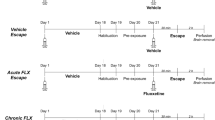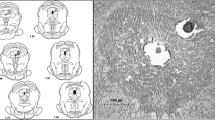Abstract
Rationale
Electrical stimulation of the dorsal periaqueductal gray (dPAG) evokes escape, a defensive response associated with panic attacks. Stimulation of 5-HT1A or 5-HT2A receptors in this midbrain area equally inhibits escape performance, even though at the molecular level these receptors cause opposite effects, i.e., activation of the former hyperpolarizes the cell membrane, while the latter excites it. A proposal has been made that 5-HT2A receptor agonists exert their inhibitory effect on escape by activating GABAergic interneurons located in the dPAG.
Objectives
In the present study, we evaluated this hypothesis by investigating whether previous intra-dPAG administration of the GABAA receptor antagonist bicuculline blocks the anti-escape effect caused by the local injection of different 5-HT2A/2C receptor agonists.
Results
Intra-dPAG administration of 5-HT, the preferential 5-HT2A receptor agonist DOI, the nonselective 5-HT2C receptor agonist mCPP or the 5-HT2C receptor agonist RO 60–0175 significantly inhibited the escape reaction induced by electrical stimulation of the same brain area. In all cases, this panicolytic-like effect was blocked by previous microinjection of bicuculline. This GABAA antagonist, however, failed to antagonize the anti-escape effect caused by the 5-HT1A receptor agonist 8-OH-DPAT. The inhibitory effect caused by DOI, RO 60–0175, and mCPP was also blocked by previous intra-dPAG injection of the preferential 5-HT2A receptor antagonist ketanserin. Pre-administration of the 5-HT2C receptor antagonist SB-242084 in the dPAG did not block the anti-escape effect of RO 60–0175.
Conclusions
Stimulation of 5-HT2A but not 5-HT2C receptors in the dPAG causes a panicolytic-like effect that is mediated by facilitation of GABAergic neurotransmission.





Similar content being viewed by others
References
Adams DB (1968) Cells related to fighting behavior recorded from midbrain central gray neuropil of cat. Science 159:894–896
Audi EA, Graeff FG (1984) Benzodiazepine receptors in the periaqueductal grey mediate anti-aversive drug action. Eur J Pharmacol 103:279–285
Blanchard RJ, Yudko EB, Rodgers RJ, Blanchard DC (1993) Defense system psychopharmacology: an ethological approach to the pharmacology of fear and anxiety. Behav Brain Res 58:155–165
Boothman L, Raley J, Denk F, Hirani E, Sharp T (2006) In vivo evidence that 5-HT(2C) receptors inhibit 5-HT neuronal activity via a GABAergic mechanism. Br J Pharmacol 149:861–869
Brandão ML, Lopoz-Garcia JA, Graeff FG, Roberts MHT (1991) Electrophysiological evidence for excitatory 5-HT2 and depressant 5-HT1A receptors on neurones of the rat midbrain tectum. Brain Res 556:259–266
Bubar MJ, Cunningham KA (2007) Distribution of serotonin 5-HT2C receptors in the ventral tegmental area. Neuroscience 146:286–297
Casarotto PC, de Bortoli VC, de Aguiar Corrêa FM, Moraes Resstel LB, Zangrossi H (2010) Panicolytic-like effect of BDNF in the rat dorsal periaqueductal grey matter: the role of 5-HT and GABA. Int J Neuropsychopharmacol 5:1–10
de Bortoli VC, Nogueira RL, Zangrossi H Jr (2006) Effects of fluoxetine and buspirone on the panicolytic-like response induced by the activation of 5-HT1A and 5-HT2A receptors in the rat dorsal periaqueductal gray. Psychopharmacology (Berl) 183:422–428
de Bortoli VC, Nogueira RL, Zangrossi H Jr (2008) Alprazolam potentiates the antiaversive effect induced by the activation of 5-HT(1A) and 5-HT (2A) receptors in the rat dorsal periaqueductal gray. Psychopharmacology (Berl) 198:341–349
Del-Ben CM, Graeff FG (2009) Panic disorder: is the PAG involved? Neural Plast 1–9.
Donatti AF, Panissi CRAL (2009) GABAergic antagonist blocks the reduction of tonic immobility behavior induced by activation of 5-HT2 receptors in the basolateral nucleus of the amygdala in guinea pigs. Brain Res Bull 79:358–364
Graeff FG (2002) On serotonin and experimental anxiety. Psychopharmacology 163:467–476
Graeff FG (2003) Serotonin, periaqueductal gray matter and panic disorder. Rev Bras Psiquiatr Suppl 2:42–45
Graeff FG (2004) Serotonin, the periaqueductal gray and panic. Neurosci Biobehav Rev 28:239–259
Graeff FG, Zangrossi H Jr (2010) The dual role of serotonin in defense and the mode of action of antidepressants on generalized anxiety and panic disorders. Cent Nerv Syst Agents Med Chem 10:207–217
Graeff FG, Brandão ML, Audi EA, Schütz MT (1986) Modulation of the brain aversive system by GABAergic and serotonergic mechanisms. Behav Brain Res 22:173–180
Graeff FG, Audi EA, Almeida SS, Graeff EO, Hunziker MH (1990) Behavioral effects of 5-HT receptor ligands in the aversive brain stimulation, elevated plus-maze and learned helplessness tests. Neurosci Biobehav Rev 14:501–506
Graeff FG, Netto CF, Zangrossi H Jr (1998) The elevated T-maze as an experimental model of anxiety. Neurosci Biobehav Rev 23:237–246
Griffts JL, Lovick TA (2002) Co-localization of 5-HT2A receptors and GABA immunoreactivity in neurones in the periaqueductal grey matter of the rat. Neurosci Lett 326:151–154
Hoyer D, Hannon JP, Martin GR (2002) Molecular, pharmacological and functional diversity of 5-HT receptors. Pharmacol Biochem Behav 71:533–554
Jacob CA, Cabral AH, Almeida LP, Magierek V, Ramos PL, Zanoveli JM, Landeira-Fernandez J, Zangrossi H Jr, Nogueira RL (2002) Chronic imipramine enhances 5-HT(1A) and 5-HT(2) receptors-mediated inhibition of panic-like behavior in the rat dorsal periaqueductal gray. Pharmacol Biochem Behav 72:761–766
Jenck F, Moreau JL, Martin JR (1995) Dorsal periaqueductal gray-induced aversion as a simulation of panic anxiety: elements of face and predictive validity. Psychiatry Res 57:181–191
Jiang X, Xing G, Yang C, Verma A, Zhang L, Li H (2009) Stress impairs 5-HT2A receptor-mediated serotonergic facilitation of GABA release in juvenile rat basolateral amygdala. Neuropsychopharmacology 34:410–423
Knight AR, Misra A, Quirk K, Benwell K, Revell D, Kennett G, Bickerdike M (2004) Pharmacological characterisation of the agonist radioligand binding site of 5-HT(2A), 5-HT(2B) and 5-HT(2C) receptors. Naunyn Schmiedebergs Arch Pharmacol 370:114–123
Liu S, Bubar MJ, Lanfranco MF, Hillman GR, Cunningham KA (2007) Serotonin2C receptor localization in GABA neurons of the rat medial prefrontal cortex: implications for understanding the neurobiology of addiction. Neuroscience 146:1677–1688
Lovick TA, Parry DM, Stezhka VV, Lumb BM (2000) Serotonergic transmission in the periaqueductal gray matter in relation to aversive behaviour: morphological evidence for direct modulatory effects on identified output neurons. Neuroscience 95:763–772
Marseillan RF (1977) A solid state sine-wave stimulator. Physiol Behav 19:339–340
Massé F, Hascoët M, Bourin M (2007) Effect of GABAergic ligands on the anxiolytic-like activity of DOI (a 5-HT(2A/2C) agonist) in the four-plate test in mice. Eur Neuropsychopharmacol 17:483–491
Mobbs D, Petrovic P, Marchant JL, Hassabis D, Weiskopf N, Seymour B, Dolan RJ, Frith CD (2009) When fear is near. Science 317:1079–1083
Nashold BS Jr, Wilson WP, Slaughter DG (1969) Sensations evoked by stimulation in the midbrain of man. J Neurosurg 30:14–24
Nashold BS Jr, Wilson WP, Slaughter DG (1974) The midbrain and pain. In: Bonica JJ (ed) Advances in neurology. International Symposium on Pain, vol 4. Raven, New York, pp 191–196
Nogueira RL, Graeff FG (1995) Role of 5-HT receptor subtypes in the modulation of dorsal periaqueductal gray generated aversion. Pharmacol Biochem Behav 52:1–6
Paxinos G, Watson C (2007) The rat brain in stereotaxic coordinates, 6th edn. Elsevier Academic Press, San Diego
Poltronieri SC, Zangrossi H Jr, de Barros VM (2003) Antipanic-like effect of serotonin reuptake inhibitors in the elevated T-maze. Behav Brain Res 147:185–192
Schenberg LC, Bittencourt AS, Sudré EC, Vargas LC (2001) Modeling panic attacks. Neurosci Biobehav Rev 25:647–659
Schutz MTB, Aguiar JC, Graeff FG (1985) Anti-aversive role of serotonin in the dorsal periaqueductal grey matter. Psychopharmacology 85:340–345
Teixeira RC, Zangrossi H, Graeff FG (2000) Behavioral effects of acute and chronic imipramine in the elevated T-maze model of anxiety. Pharmacol Biochem Behav 65:571–576
Vicente MA and Zangrossi H Jr (2011) Serotonin 2C receptors in the basolateral nucleus of the amygdala mediate the anxiogenic effect of acute imipramine and fluoxetine administration. Int J Neuropsychopharmacol. doi:101017/5146114511000873
Yamashita PS, de Bortoli VC, Zangrossi H Jr (2011) 5-HT2C receptor regulation of defensive responses in the rat dorsal periaqueductal gray. Neuropharmacology 60:216–222
Zangrossi H Jr, Vianna MB, Zanoveli J, Bueno C, Nogueira RL, Graeff FG (2001) Serotonergic regulation of inhibitory avoidance and one-way escape in the rat elevated T-maze. Neurosci Biobehav Rev 25:637–645
Zanoveli JM, Nogueira RL, Zangrossi H Jr (2003) Serotonin in the dorsal periaqueductal gray modulates inhibitory avoidance and one-way escape behaviors in the elevated T-maze. Eur J Pharmacol 473:153–161
Zanoveli JM, Nogueira RL, Zangrossi H Jr (2005) Chronic imipramine treatment sensitizes 5-HT1A and 5-HT 2 A receptors in the dorsal periaqueductal gray matter: evidence from the elevated T-maze test of anxiety. Behav Pharmacol 16:543–552
Acknowledgments
The authors thank Afonso Paulo Padovan for helpful technical support. The experiments described in this manuscript were funded by CAPES, FAPESP, and CNPq, Brazil.
Competing interests
All authors report no competing interests.
Author information
Authors and Affiliations
Corresponding author
Rights and permissions
About this article
Cite this article
de Oliveira Sergio, T., de Bortoli, V.C. & Zangrossi, H. Serotonin-2A receptor regulation of panic-like behavior in the rat dorsal periaqueductal gray matter: the role of GABA. Psychopharmacology 218, 725–732 (2011). https://doi.org/10.1007/s00213-011-2369-2
Received:
Accepted:
Published:
Issue Date:
DOI: https://doi.org/10.1007/s00213-011-2369-2




